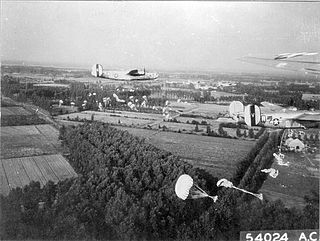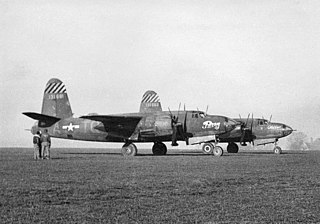
The 379th Air Expeditionary Wing is a provisional United States Air Force unit assigned to Air Combat Command. As a provisional unit, it may be activated or inactivated at any time.

The 419th Flight Test Squadron is a United States Air Force squadron. It is assigned to the 412th Operations Group, Air Force Materiel Command, stationed at Edwards Air Force Base, California.

The 531st Bombardment Squadron was a unit of the US Air Force, first activated during World War II. After training as a heavy bomber unit in the United States, it moved to the Southwest Pacific Theater, entering combat in May 1943, flying combat missions from Australia while attached to the Royal Australian Air Force, earning two Distinguished Unit Citations and a Philippine Presidential Unit Citation. In 1945 it moved forward to the Philippines, then to Okinawa. Following V-J Day, the squadron returned to the Philippines and was inactivated there in February 1946.

The 506th Bombardment Squadron is an inactive United States Air Force unit. It was last assigned to the 44th Bombardment Wing at Chennault Air Force Base, Louisiana, where it was inactivated on 15 June 1960.

The 547th Bombardment Squadron is an inactive United States Air Force unit. It was first activated during World War II as a Boeing B-17 Flying Fortress unit. After training in the United States, it deployed to the European Theater of Operations, where it participated in the strategic bombing campaign against Germany, earning two Distinguished Unit Citations. Following V-E Day, the squadron moved to France and was inactivated there in early 1946.

The 526th Bombardment Squadron is an inactive United States Air Force unit. It was last assigned to the 4042d Strategic Wing at K. I. Sawyer Air Force Base, Michigan, where it was inactivated on 1 February 1963 when Strategic Air Command replaced its MAJCON wings with wings that could continue a heritage.

The 525th Bombardment Squadron is an inactive United States Air Force unit. It was last assigned to the 4136th Strategic Wing at Minot Air Force Base, North Dakota, where it was inactivated on 1 February 1963 when Strategic Air Command replaced its MAJCON wings with wings that could continue a heritage.

The 524th Bomb Squadron is an inactive United States Air Force unit. It was last assigned to the 379th Bombardment Wing at Wurtsmith Air Force Base, Michigan, and was inactivated on 15 December 1992 as the base was drawing down prior to closure.

The 515th Bombardment Squadron is an inactive United States Air Force unit. It was first formed in the Middle East in 1942 to reinforce the Royal Air Force in North Africa with personnel and aircraft diverted from delivery to the China Burma India Theater. The squadron moved forward, eventually being stationed in Italy, where it participated in the strategic bombing campaign against Germany, and was awarded three Distinguished Unit Citations for its combat actions. Following V-E Day, the squadron returned to the United States, where it converted to Boeing B-29 Superfortress bombers, but was inactivated in March 1946.

The 424th Bombardment Squadron is an inactive United States Air Force unit. Its last assignment was with the 307th Bombardment Wing at Lincoln Air Force Base, Nebraska, where it was inactivated on 1 January 1962.

The 425th Bombardment Squadron is an inactive United States Air Force unit. Its last assignment was with 308th Bombardment Wing at Plattsburgh Air Force Base, New York, where it was inactivated in 1961.

The 423d Bombardment Squadron is an inactive United States Air Force unit. Its last assignment was with the 306th Bombardment Wing at MacDill Air Force Base, Florida.

The 353d Bombardment Squadron is an inactive United States Air Force unit. It last was assigned to the 301st Bombardment Wing, stationed at Lockbourne Air Force Base, Ohio. It was inactivated on 8 June 1964.

The 352d Bombardment Squadron is an inactive United States Air Force unit. It was last assigned to the 301st Bombardment Wing at Lockbourne Air Force Base, Ohio, where it was inactivated on 8 June 1964.

The 969th Airborne Warning and Control Squadron is an inactive United States Air Force unit. It was formed in 1985 by the consolidation of the 559th and 659th Bombardment Squadrons.

The 379th Space Range Squadron is an Air Force Reserve unit. It is assigned to the 926th Wing at Schriever Air Force Base, Colorado. It is a reserve associate squadron of United States Space Force's 25th Space Range Squadron.

The 422d Bombardment Squadron is an inactive United States Air Force unit. Its last assignment was with the 305th Bombardment Wing at Bunker Hill Air Force Base, Indiana, where it was inactivated on 15 February 1961. The squadron was first activated in March 1942 as the 32d Reconnaissance Squadron, but shortly was renamed as a bombardment unit. After training in the United States, it moved to England in the fall of 1942, where it participated in the strategic bombing campaign against Germany, earning a Distinguished Unit Citation for its actions. Following V-E Day, the squadron moved to Germany, where it formed part of the occupation forces until inactivating in December 1946.

The 366th Bombardment Squadron is an inactive United States Air Force unit. It was first activated in March 1942. After training with Boeing B-17 Flying Fortress bombers in the United States, the squadron deployed to the European Theater of Operations, where it participated in the strategic bombing campaign against Germany. The squadron was twice awarded the Distinguished Unit Citation for its combat actions. Following V-E Day, it moved to the continent of Europe and engaged in photographic mapping until inactivating in December 1946.

The 365th Bombardment Squadron is an inactive United States Air Force unit. It was first activated in March 1942. After training with Boeing B-17 Flying Fortress bombers in the United States, the squadron deployed to the European Theater of Operations, where it participated in the strategic bombing campaign against Germany. The squadron was twice awarded the Distinguished Unit Citation for its combat actions. Following V-E Day, it moved to the continent of Europe and engaged in photographic mapping until inactivating in December 1946.

The 860th Bombardment Squadron is a former United States Army Air Forces unit that was assigned to the 493d Bombardment Group during World War II. It was part of the last bombardment group to be assigned to Eighth Air Force. It flew combat missions until V-E Day, then returned to the United States for inactivation. In 1985, the squadron was consolidated with the 660th Bombardment Squadron, a Strategic Air Command unit that flew Boeing B-47 Stratojets during the Cold War. Although the two squadrons were consolidated as the 967th Airborne Warning and Control Squadron, they have never been active under that designation.























